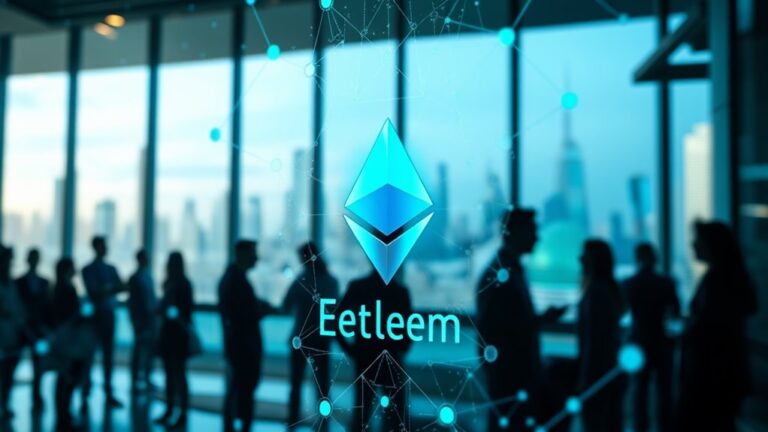
Ethereum 2.0 and Proof of Stake Upgrade: How It Works and Its Benefits
Ethereum 2.0 represents a significant upgrade that shifts the network from proof-of-work to proof-of-stake consensus. This change reduces energy consumption by approximately 99.95% while improving scalability and security. Validators replace miners, staking 32 ETH to participate in block validation and earn rewards. The upgrade includes the Beacon Chain and future sharding implementation, potentially enabling 100,000 transactions per second. These improvements create economic opportunities for ETH holders through staking while supporting a more sustainable and efficient blockchain ecosystem.
Key Takeaways
- Ethereum 2.0 transitioned from energy-intensive proof-of-work to proof-of-stake, reducing energy consumption by 99.95%.
- Validators stake 32 ETH as collateral and earn rewards for honestly validating transactions and creating blocks.
- The Beacon Chain coordinates validators and will eventually enable sharding to process up to 100,000 transactions per second.
- Validators are selected through a pseudorandom process using RANDAO, with rewards proportional to effective balance and participation.
- Staking creates passive income opportunities while slashing mechanisms penalize dishonest behavior, ensuring network security.
The Evolution From Ethereum 1.0 to 2.0

Since its initial launch, Ethereum has undergone significant transformations to address its limitations and enhance its capabilities.
The most notable evolution is the shift from a proof-of-work consensus mechanism in Ethereum 1.0 to a proof-of-stake model in Ethereum 2.0. This change drastically reduces energy consumption while improving scalability and security.
The shift to Ethereum 2.0 follows a phased approach that began with the Beacon Chain in December 2020, enabling staking functionality.
The pivotal “Merge” was completed in September 2022, integrating the Beacon Chain with the mainnet.
Future developments include sharding, which will divide the blockchain into 64 shard chains to increase transaction capacity.
These upgrades make the network more user-friendly and accessible while maintaining compatibility with existing ETH tokens. Additionally, the transition to Ethereum 2.0 is expected to enhance transaction speeds and reduce gas fees, making the platform more appealing to users.
Understanding Proof of Stake: Core Mechanics Explained

In Ethereum 2.0’s Proof of Stake system, validators are selected to propose and verify blocks based primarily on the size of their stake, with larger stakes increasing selection probability.
The economic structure requires validators to lock up 32 ETH as collateral, creating financial incentives for honest participation while discouraging malicious behavior through potential rewards of newly minted ETH and transaction fees.
Security is maintained through a penalty mechanism called “slashing,” where validators who act dishonestly or remain inactive can lose portions of their staked ETH, effectively making attacks on the network financially impractical. Additionally, participating in staking pools allows users with less than 32 ETH to also earn rewards while contributing to network security.
Validator Selection Process
Ethereum’s validator selection process operates through a carefully designed pseudorandom system that balances fairness with security in the Proof of Stake consensus mechanism. Validators are selected for block proposal duties based on their staked ETH amount, with larger stakes resulting in higher selection probability.
The process relies on the RANDAO algorithm, which creates unpredictable yet verifiable randomness for validator assignments. The network organizes validators into committees during each epoch, distributing them across different slots. This committee structure enhances decentralization while maintaining network efficiency.
For each slot in the blockchain, a specific validator is chosen to propose a new block, while others serve as attesters who verify and vote on the block’s validity. This rotation of duties guarantees no single validator can dominate the consensus process. Additionally, the implementation of Layer 2 solutions allows the Ethereum network to handle increased transaction volumes, further improving its scalability.
Staking Economics Explained
While validator selection focuses on the technical mechanisms of participation, the economic foundation of Proof of Stake represents the financial engine that powers Ethereum 2.0’s consensus system.
This model creates a self-sustaining economy where validators lock up 32 ETH as collateral to participate in block validation.
The economic incentives are twofold: validators earn block rewards for successfully proposing and attesting blocks, plus they collect transaction fees from processed transactions.
This dual revenue stream encourages honest behavior, as validators risk losing their staked ETH through slashing penalties if they act maliciously.
Unlike energy-intensive Proof of Work systems, PoS considerably reduces operational costs while maintaining security through financial stakes.
This economic structure not only secures the network but potentially stabilizes ETH’s value by reducing circulating supply through staking. Additionally, the interconnected nature of the DeFi ecosystem allows for innovative financial products that leverage staked assets for further economic activities.
Security Through Penalties
Security represents the foundation of any robust blockchain system, and Ethereum 2.0’s Proof of Stake introduces a sophisticated penalty framework designed to enforce network integrity. This framework, known as the slashing mechanism, reduces or removes a validator’s stake when they engage in malicious behavior.
Validators face penalties in several scenarios. When they go offline or fail to validate blocks, they lose a portion of their stake. More severe consequences occur for those who attempt to propose or attest to fraudulent blocks. Additionally, validators attesting to invalid blocks face significant penalties.
These economic disincentives create a powerful security model where dishonest actions become financially detrimental. By making validators risk their own assets, Ethereum 2.0 creates strong motivation for honest participation, ultimately safeguarding the network against potential attacks and maintaining system reliability. Furthermore, this mechanism helps mitigate risks associated with smart contract vulnerabilities, ensuring a more secure environment for users and developers alike.
Validator Roles and Responsibilities in Ethereum 2.0

The validator selection process in Ethereum 2.0 is based on a random algorithm that prioritizes nodes with higher staked ETH and longer participation history.
Validators receive rewards through a structured system that distributes newly minted ETH and a portion of transaction fees based on their participation in block proposals and attestations.
These financial incentives encourage validators to maintain high uptime and honest behavior, as penalties for malicious actions can result in significant loss of staked funds. Additionally, the shift to proof-of-stake (PoS) enhances the overall network’s efficiency and sustainability.
Validator Selection Process
How exactly does Ethereum 2.0 choose which validators propose blocks at any given moment? The process combines randomness with stake-weighted probability to guarantee fairness and security.
Validators are pseudorandomly selected based on their effective balance, with those staking more ETH having proportionally higher chances of being chosen. This selection occurs within epochs—6.4-minute cycles where validators are assigned specific roles as either block proposers or attesters.
Most validators serve as attesters, verifying proposed blocks and voting on the chain’s state. New validators must wait in an activation queue before participating, preventing sudden network disruptions from large validator influxes.
This carefully designed selection mechanism maintains network decentralization while providing predictable opportunities for participation proportional to each validator’s 32 ETH minimum stake. Additionally, this approach is essential for enhancing transaction efficiency in the Ethereum ecosystem, as it ensures a well-distributed validation process.
Validator Reward Structure
Once validators are selected through the process outlined above, they participate in a carefully structured reward system designed to motivate proper network behavior. The reward structure balances incentives with responsibilities to maintain network security and performance.
Validators earn rewards from three primary sources:
- New ETH issuance that serves as the base reward for participation
- Priority fees collected from user transactions included in proposed blocks
- Maximal extractable value (MEV) opportunities when selected to propose blocks
These rewards are proportional to a validator’s effective balance and the overall network participation rate. Timely and accurate attestations yield higher rewards, while penalties apply for inactivity.
Serious violations can result in slashing, where validators lose portions of their 32 ETH stake. This system guarantees validators remain motivated to contribute positively to Ethereum’s security. Moreover, this reward structure is crucial for maintaining network performance and incentivizing validators to act in the best interest of the Ethereum ecosystem.
The Beacon Chain: Foundation of Ethereum’s New Consensus

Serving as the backbone of Ethereum’s ambitious 2.0 upgrade, the Beacon Chain represents a revolutionary shift in how the network reaches consensus. Launched in 2020 as a separate blockchain, it functions as the consensus layer that coordinates validators and manages the proof-of-stake system.
Operating in 12-second slots grouped into epochs of approximately 6.4 minutes, the Beacon Chain organizes validators into committees that validate blocks. Randomly selected proposers create blocks while attesters vote on their validity, ensuring decentralization and security. This structure makes 51% attacks more difficult, as attackers would need to control a majority of staked ETH.
Beyond security improvements, the Beacon Chain markedly reduces energy consumption compared to the previous proof-of-work system, making Ethereum more sustainable and efficient. Additionally, this shift towards decentralized finance reflects a broader trend of utilizing blockchain technology to enhance the accessibility and efficiency of financial services.
Sharding: How Ethereum Plans to Scale for Mass Adoption

Scalability represents one of Ethereum’s most significant challenges in its journey toward mass adoption. To address this limitation, Ethereum is implementing sharding—a technique that divides the blockchain into smaller parts called shards, allowing for parallel transaction processing.
Ethereum’s sharding approach includes:
- Creating 64 shards with 128 validators each, enabling the network to potentially process up to 100,000 transactions per second compared to the current 13 TPS.
- Implementing “blob sharding” as part of the danksharding approach, which distributes data more efficiently than traditional shard chains.
- Reducing gas fees and latency while increasing throughput by spreading the workload across multiple shards, making the network more accessible for users.
Despite its benefits, sharding introduces challenges regarding security and cross-shard transactions. Additionally, successful implementation of sharding is crucial for achieving decentralized finance (DeFi) applications that can scale effectively in the Ethereum ecosystem.
Environmental Impact: Energy Efficiency of Proof of Stake

While sharding promises to solve Ethereum’s scalability issues, the network’s environmental footprint has emerged as another pressing concern in blockchain development. Ethereum’s shift from Proof of Work to Proof of Stake, known as “The Merge,” reduced energy consumption by approximately 99.95%.
| Comparison | Proof of Work | Proof of Stake | Impact |
|---|---|---|---|
| Energy Use | ~100-200 TWh annually | MWh range | 99.95% reduction |
| Hardware Requirements | Specialized mining equipment | Standard computers | Lower resource demand |
| Scalability | Limited by energy constraints | Higher transaction capacity | Better performance |
| Carbon Footprint | Significant emissions | Minimal environmental impact | Supports climate goals |
| Sustainability | Difficult to power with renewables | Compatible with green energy | Future-proof solution |
This dramatic efficiency improvement positions Ethereum as an environmentally responsible blockchain platform, consuming energy equivalent to just 2,100 American households rather than an entire country.
Economic Implications for ETH Holders and Investors

As Ethereum shifts to its 2.0 version with Proof of Stake consensus, significant economic opportunities emerge for both holders and investors of ETH. The change creates a new financial landscape within the Ethereum ecosystem that rewards participation and long-term commitment.
- Staking rewards provide passive income potential for ETH holders who lock their assets in the network, with returns proportional to the amount staked while simultaneously reducing circulating supply.
- Market dynamics may favor investors as reduced supply combines with enhanced utility, potentially increasing ETH’s value despite some liquidity risks.
- Governance participation becomes available to stakeholders, allowing them to influence network decisions while contributing to a more decentralized system that supports expanding DeFi and NFT markets.
The Road Ahead: Challenges and Opportunities for Ethereum 2.0

The evolution of Ethereum into its 2.0 version represents both a technological milestone and a complex journey filled with potential hurdles and promising developments.
Ethereum 2.0: a technological milestone navigating a complex landscape of challenges and opportunities
While the upgrade promises significant improvements in scalability, energy efficiency, and security, several challenges remain on the horizon.
Implementation complexity poses a substantial obstacle, requiring seamless integration of multiple components without introducing vulnerabilities. Additionally, Ethereum faces strong competition from alternative blockchains like Solana and Cardano, which already offer scalable solutions.
Success ultimately depends on adoption rates among developers and users.
Despite these challenges, Ethereum 2.0‘s roadmap includes promising developments such as proto-danksharding for further scalability improvements.
The dramatic reduction in energy consumption positions the network favorably amid growing environmental concerns, potentially attracting environmentally conscious users and meeting global sustainability standards.
Frequently Asked Questions
How Do Hardware Requirements for Validators Compare to Mining?
Validator hardware requirements are less demanding than mining rigs, needing fewer CPU cores and less energy. They require less frequent upgrades, have lower operational costs, and offer greater durability over time.
What Happens if a Validator Loses Internet Connection?
If a validator loses internet connection, they face penalties including missed rewards and potential slashing. Persistent outages can greatly impact their balance and participation in the network’s consensus process.
Can Slashed Validators Ever Participate in Consensus Again?
Slashed validators can participate in consensus again, though the path is challenging. They must exit the network completely, re-deposit the required ETH, and endure the activation queue before resuming validation duties.
How Are Validator Rewards Taxed in Different Jurisdictions?
Validator rewards are taxed differently across jurisdictions. Most countries treat them as taxable income upon receipt, with variations in rates and classification as either ordinary income or capital gains depending on local regulations.
Will Ethereum 2.0 Support Cross-Chain Interoperability With Bitcoin?
Ethereum 2.0 currently lacks native cross-chain interoperability with Bitcoin. While it focuses on sharding and rollups for scalability, third-party bridges exist for asset transfers between the networks, despite security limitations.
Conclusion
Ethereum 2.0’s shift to proof of stake represents a watershed moment in blockchain evolution. Like a caterpillar transforming into a butterfly, this upgrade sheds the energy-intensive mechanisms of its past while embracing a more sustainable, scalable future. As validators replace miners and sharding enhances throughput, Ethereum positions itself to meet growing demand while addressing environmental concerns—potentially cementing its place as the foundation for Web3 applications in the years ahead.












